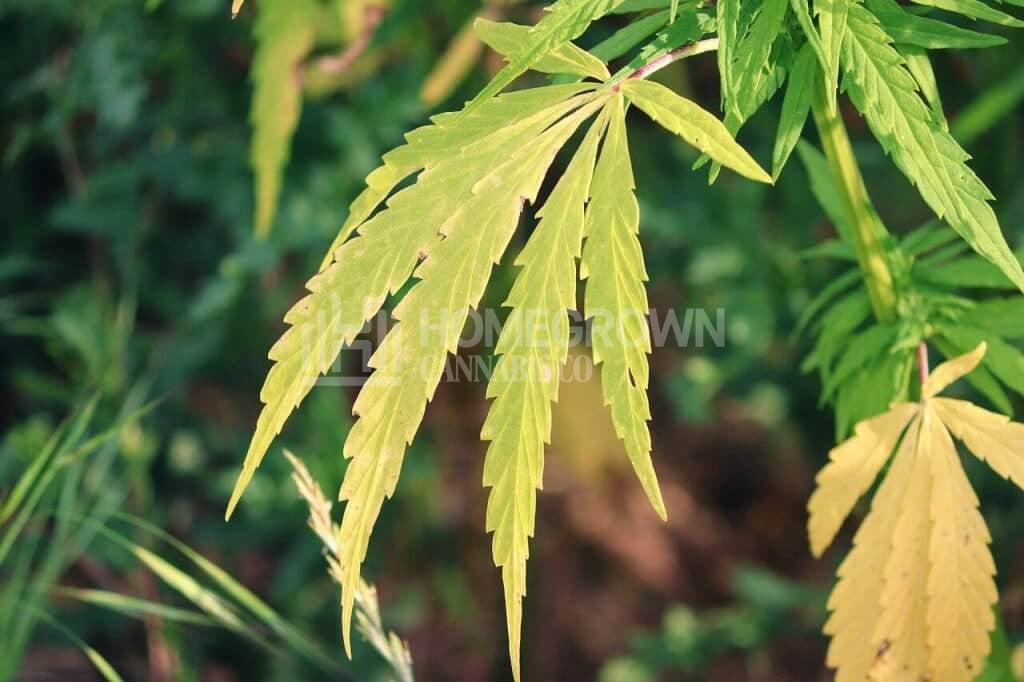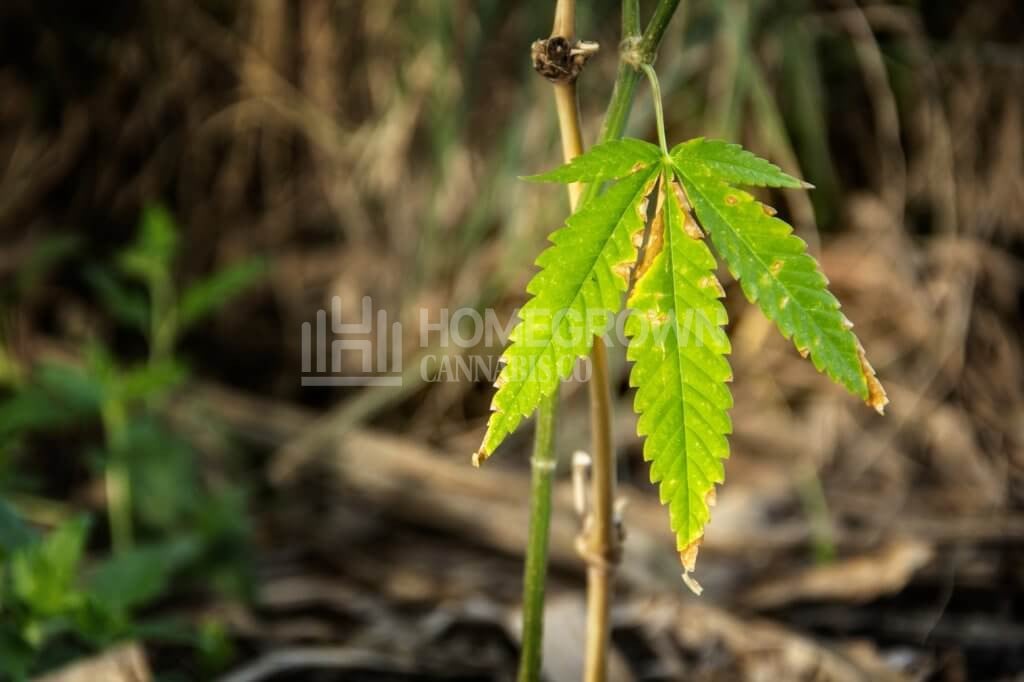Potassium Deficiency in Weed: Causes, Symptoms, And Treatments
Knowing the dangers of a potassium deficiency in weed is essential, whether you’re popping your first seeds or you’re a master cultivator.
Potassium is an important nutrient for growing cannabis plants. It helps build strong cell walls and aids in the production of chlorophyll. For these reasons, this nute is a crucial element in your feeding regimen to grow healthy, happy weed crops.
What happens when your plants show signs of a K shortage despite you feeding them plenty? There could be many reasons why this is happening. We’re going to talk about some causes and treatments for potassium deficiencies in cannabis plants.
Let’s begin!

What is potassium deficiency?
Potassium (K) is an essential macronutrient that plays many important roles in your weed plants, both as a mineral and part of certain molecules. You’ll find the highest concentration within the leaves.
Potassium deficiency symptoms start to show when K levels are too low for optimal growth to take place. When you notice these symptoms, your plants can no longer take minerals up from the soil.
Potassium deficiency in cannabis is most common when a grower uses heavily depleted soils or over-treated tap water. However, even growers who use highly organic nutes can sometimes experience K shortages if they maintain a high pH environment.
The best way to prevent cannabis potassium deficiency is by keeping your pH around or below seven.
What does potassium do for plants?
Plants need potassium to grow and survive. It helps your crops remain healthy and produce high yields. It aids with elongating cells, protein synthesis, chlorophyll production, enzyme functions, photosynthesis processes, and more.
K also promotes leaf growth by encouraging cell division, which means more leaves, branches, and other plant parts. It helps the stems of crops become stronger, so they can support more weight & growth.
Once you understand what your plants use it for, solving a potassium deficiency in weed becomes easier.
What causes cannabis potassium deficiency?
Cannabis potassium deficiency is one of the most common nutrient shortages in weed and can happen for several reasons. Here are some common causes that we see at various points during the growth cycle.
Lighting
Make sure your lights are in good working order before modifying your growing medium or watering solution. You might be overheating the leaves with strong LED or HPS grow lights, even if the rest of the plant is cool. Using the lighting incorrectly is often a source of cannabis potassium deficiency.
Too Little or Too Many Nutrients
If the lights aren't the problem, an overabundance of fertilizers and nutrients in the soil where salt accumulates may be to blame. If you're certain this is the cause, drain with clean water. Make sure to keep an eye on pH levels, EC/PPM (soil meters come in handy here), and overall nutrient content.
Overwatering must be taken care of quickly because it can cause root damage, leading directly to potassium deficiency in weed.
If you're growing in coco, getting a nutrient lockout is possible, especially if the pH is off balance or too low. It often leads to other deficiencies and plant stress, so be sure to address this before moving forward to avoid permanent damage.
If you feed your cannabis often, check for any build-up of salts that can accumulate in the grow medium. Although easy to solve, this is one of the most overlooked causes of potassium deficiency during flowering.
If you suspect that your issue might be related to high concentrations of ammoniacal nitrogen (NH4+), also known as urea, then flush with clean water and reduce the nutrient solution strength by half.
If cannabis potassium deficiency occurs in the flowering stage, it's usually due to a lack of calcium, which can cause problems during key stages of flower development. Flush with clean water and reduce the nutrient solution strength by half, including all additional amendments.
Calcium helps activate certain enzymes during flowering, so if you don't have adequate levels, your plants won't be able to process potassium.
Not Enough Aeration
When growing in soil, marijuana potassium deficiency can also occur due to lack of aeration. It means it's easy to get ammonia or nitrogen toxicity because the plants cannot access nutrients present in the medium properly.
With this issue, roots won't perform optimally, and your plant experiences stress and, eventually, cannabis potassium deficiency.
What happens when you have a potassium deficiency during flowering?
K is an essential nutrient during the flowering stage. When the plant doesn't have enough in its system, it looks spindly and has poorly developed buds. So if you see any signs of cannabis potassium deficiency on your crops, start with treatment immediately.
Signs of potassium deficiency in weed plants
Potassium deficiencies in weed often resemble iron shortages. The tell-tale way of knowing that your crop lacks K is by curling leaves, burnt edges, and leaf death. Another sign to look out for is leaf color, especially:
- Leaves that are brown, burnt, or pale.
- Low hanging or older blades turn yellow.
- Dark brown spots.
Other symptoms you should check for on your plants include:
- Stunted or abnormal growth.
- Leaves curling upward or under.
- Stretching that’s identified by large spaces between nodes.
- Buds that aren’t fattening.
How to treat a marijuana potassium deficiency
There are quite a few ways to treat a potassium deficiency in weed, so here we will delve into several that might help.
Treat the plant's pH level
Always be sure to keep the pH level of your medium level. For soil, that would be around 6.0–7.0. For other mediums such as coco coir or hydro systems, try to have a pH level of around 5.5–6.5.
If you suspect that the pH level is the root of your cannabis potassium deficiency, then there’s a simple solution. You can easily cleanse your plants by flushing the medium. It’s a simple process in which you use neutral pH water and run it through your growing medium to flush out all the excess nutes.
After that, you can start re-adding your nutrients at the correct level.
Avoid overwatering
With further elaboration on the previous tactic for potassium deficiency in weed, you should avoid flushing your medium by accident. Don’t water your plant too often or too much at a time. It might take out all those yummy nutrients the plant needs. Adjust your watering schedule if you need to.
Adjust your nutrients
Keeping your plant well-fed sometimes feels like a big struggle, especially when you start using supplements. As a best practice, read what side effects each fertilizer might cause before applying it. Changing the brand you use or the amount you apply could eliminate that pesky cannabis potassium deficiency in no time.
Certain nutrients are good to have a lot of, but they might make it difficult for the plant to absorb other important ones. A good example is nitrogen and calcium, which can decrease how well the plant absorbs potassium.
Use potassium sulfate fertilizer
You can treat marijuana potassium deficiency with potassium sulfate (K2SO4) fertilizer. You should use a ratio of around 1:2 when adding K2SO4 to your compost.
What is cannabis potassium toxicity?
Cannabis potassium toxicity is an excess of K in your plant and can cause a nutrient lockout, leading to shortages of other essential elements. This imbalance is often mistaken for a cal-mag deficit.
Unfortunately, marijuana potassium toxicity is more likely to occur than an excess of some other nutrients. The common causes are poor soil, overfeeding, or soil amendments with high K content.
Recognizing potassium toxicity
Many nutrient issues present in the same way making it difficult to diagnose. Cannabis potassium toxicity is no different. Look out for the following signs:
- Spotting and curling of lower leaves.
- Yellow/brown burn on the tips and edges of blades.
- Thinning of top leaves.
- Resembles cal-mag deficiencies.
How to treat cannabis potassium toxicity?
To control your cannabis potassium toxicity issue, you need to get your nute levels back on track. You can do that by doing the following.
- Pour the Soil Flush mixture into a container with pH-balanced water. Allow the plant to consume the remaining potassium for one week before you start feeding it again.
- In hydro, replace the water in the tank and clean out the EC.
- To eliminate EC in coco, drain and flush the substrate.

Don’t be deficient, be sufficient
Potassium deficiency in marijuana plants can be disastrous. Keep the levels of potassium high enough to prevent a deficiency from occurring again. Test your soil pH and correct accordingly since too much K can reduce uptake of other major nutrients, such as nitrogen and phosphorus.
If you’re new to growing weed, consider starting with hardy strains that are less prone to marijuana potassium deficiency. At Homegrown, we have a wide variety of magnificent cannabis seeds. Looking for something simple to grow? We’ve got you covered. Head on over to our shop to get your seeds today.
About the author: Derek LaRose
Also known as Kronic from The Cannabis Kronicles, Derek LaRose is a young ambitious cultivator and a staple educator for indoor cultivation.